Examples of writing
Alphabet table of Marsiliana d'Albegna (7th century)

Alphabetic line from the famous table of Marsiliana d'Albegna (Tuscany): a tablet with a raised edge, with its inner portion covered with a layer of wax which could be written on with a stylus; generally considered to be from the first half of 7th century BC. On the side shown here was engraved, from right to left, the oldest Etruscan alphabet known. This demonstrates the importation of the Greek alphabet by the Etruscans in an early age, and, consequently, the stabilization of the Greek alphabet (here Cumaen) before the 7th century.
Nestor's Cup (8th century)
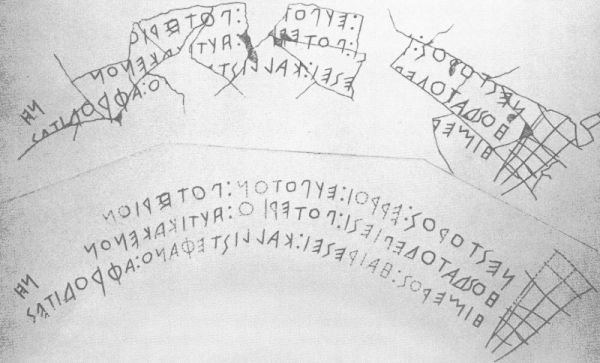
Nestor’s Cup, a ceramic find coming from the Euboean colony of Pithikoussai (Ischia) and published for the first time in 1955, indicates at the same time both how common alphabetic writing was by the 8th century and the important permeation of the Homeric epic in Greek culture. The script reads from right to left. In the upper part of the image the part of the writing that has been conserved is shown, while the lower part of the image contains the reconstruction of the editio princeps (the text we give differs in the first line). Note the signs of aspiration, a rectangle cut in the middle, at the beginning of the second and third lines.
Νέστορός: [εἰμι]: εὔποτ[ον]: ποτέριο[ν]
hὸς δ᾽ἂν το̃δε π[ίεσι]: ποτερί[ο]: αὐτίκα κε̃νον
ἵμερ[ος αἱρέ]σει: καλλιστ[εφάν]ο: ᾽Αφροδίτης
I am Nestor’s cup, good to drink from.
Whoever drinks this cup empty, straightaway
desire for beautiful-crowned Aphrodite will seize.
Dipylon Oinochoe (8th century)
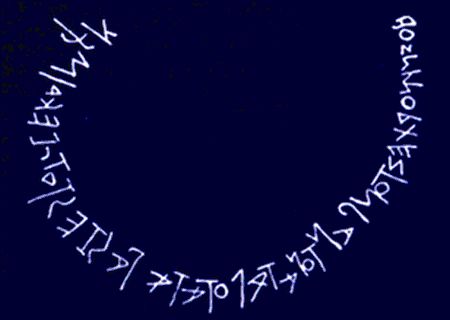
An oinochoe [wine jug] found in Athens in the Necropolis of Dipylon and roughly datable to 740 BC was the oldest form of Greek writing known to us until the discovery of Nestor’s cup. At the base of the neck it has an epigram in two verses engraved with a hard object. The first verse alludes to a sort of competition between dancers, while the second, probably incomplete, has not yet been interpreted: most probably it states that the oinochoe was the prize reserved to the most skilled dancer. It is worth noting the right-to-left script, the iota with three lines, the zeta in its oldest form (similar to an I), the symbol which developed as an heta, used to indicate aspiration (the first of the series from the right).
hὸς νῦν ὀρχηστῶν πάντων ἀταλότατα παίζει
τοτοδεκαλμιν
"The dancer who dances most delicately”
[text unclear]
Stamnos with alphabet strip from Metaponto (6th century)
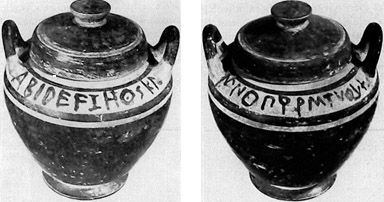
Stamnos found near the ancient city of Metaponto, datable to the beginning of the 5th century BC, kept in the museum of Taranto. At its widest point an Achaen alphabetic series was traced before baking. Note how the “san” is used in place of the sigma (image on right) and the presence of the phi and chi in the third-to-last and second-to-last places; also note the koppa sign follows the pi.
Front: Α Β Γ Δ Ε Ζ F Η Θ Ι Κ Λ
Back: Μ Ν Ο Π (koppa) Ρ Σ Τ Υ Φ Ψ Χ
Exekias' signature (6th century)
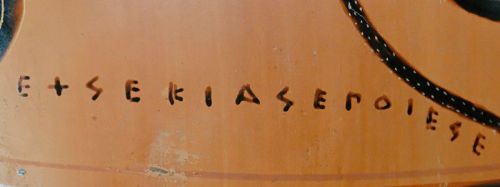
Signature of the famous painter of the vase of Geryon, now at the Louvre, and datable to the middle of the 6th century BC. Light blue Attic alphabet: the ks sound is rendered through the combination of the chi (perpendicular to the imaginary line of writing) and the sigma (with three lines, as is usual in the Athenian epigraphic script until mid-5th century BC).
᾽Εχσεκίας ἐποίεσε
"Exekias made me"
The Gortyna Code [1] (5th century)
![The Gortyna Code [1] (5th century)](assets/img/greco/esempi/ParticGortyn.jpg)
The “Laws of Gortyna” are a legal code engraved around mid-5th century on a wall that then came to light, in the Cretan town by the same name, in 1884. They are a repertory of cases and relative sentences, with indication of processes, possible punishments, number of witnesses necessary to determine “certification”, with topics ranging from testament provisions to legal action for violence. Note first of all the boustrophedon script, also the characteristics of the green alphabet of Crete, with no complementary signs, the use of the san in the place of sigma, the iota with four lines (here rounded, resembling an S). The use of a sort of half-moon for the pi is a local idiom.
θιοί. ὄς κ᾽ ἐλευθέροι ἒ δόλοι μέλλει ἀν-
πιμολὲν, πρὸ δίκας μὲ ἄγεν. αἰ δ-
έ κ᾽ ἄγει, καταδικακσάτο το̃ ἐλευθέρ-
ο δέκα στατε̃ρανς, τo δόλο πέντ-
ε oτι ἄγει καὶ δικακσάτο λαγάσαι
“He who is preparing to go into court against a free person or a slave
should not force the adversary before judgement. If he does so (the magistrate)
will sentence him to a fine of ten stateri, if the person is a free man
or of five if he is a slave, for the crime of sequestering a person, and will oblige him to release the other”
The Gortyna Code [2] (5th century)
![The Gortyna Code [2] (5th century)](assets/img/greco/esempi/Gortyna2.jpg)
Another beautiful example from the same text, in which the sign used for the theta is visible.
Athenian decree of Salamis (IG I3 1) (6th century)

Splendid example of στοιχηδÏŒν writing from the oldest extant Athenian decree. The epigraph contains prescriptions of different types for the Athenian cleruchs residing in Salamis (according to some, for the same inhabitants of the island); datable to the last part of 6th century BC.
ἔδοχσεν το̃ι δέμοι· τ̣[ὸς ἐ Σ]αλαμ̣[ῖνι κλερόχ]ος
οἰκε̃ν ἐᾶ Σαλαμῖνι [..5..]λεν [.7. ’Αθέ]νε-
σι τελε̃ν καὶ στρατ[εύεσθ]αι #53 τ̣[ὰ δ' ἐ Σαλαμῖνι] μ-
ὲ μι[σθ]ο̃ν, ἐὰ μὲ οἰκ[.7.]
Decision made by the Bulé and the people
Allow the cleruchs resident in Salamis
To live in Salamis. [...that they pay the taxes]
to Athens and do military service; that they don’t
rent [the lots of land of Salamis], if on the contrary...
Agreement between Sybarites and Serdei (6th century)

Bronze tablet from Olympia, now kept in the British Museum; it has the text of an agreement between Sybaris and another community (likely a city in southern Italy), and is datable to the last quarter of 6th century BC. The hole visible in the center of the image was used to keep the inscription on a wall. Red alphabet; note the Ψ used as a ch and the san in the place of a sigma, also the iota with three lines.
The Sybarites and their allies agree, and the (Serdei)
Dedication of Nikandre (6th century)

Transcription of the dedication in verse from a female statue found at Delos. Blu alphabet, with a few particularities: the heta sign (closed, so in the form of a rectangle cut through the middle) is apparently used both to indicate the original long e and the short e preceded by aspiration, in some cases only aspiration. Also note the use of the koppa at the beginning of the second verse.
Athenian decree for Oiniades of Skiathos (IG I3 110)

This is the heading of a famous decree, with honoring a citizen of Skiathos who had acted deservingly towards the Athenian democracy. The decree can be dated precisely at 408/407 BC because it indicates the eponymous archon Euktemon, and it represents an excellent example of the use of the Ionic alphabet before the reform.
Delos-Spartan inscription (Inscr. Dél. 6-7, 87 = IG V, 1564)
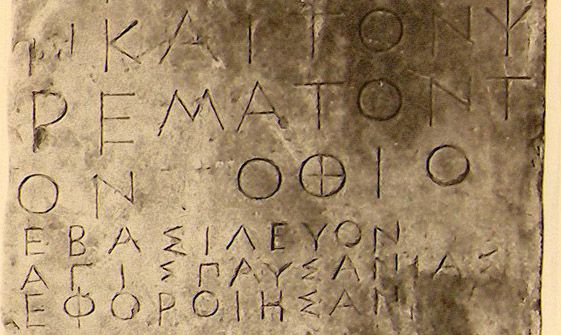
The following epigraph, which likely deals with the restitution of the rights of administration of the sanctuary of Apollo to the community of Delos, is divided into two parts. One section, in Doric dialect, written with Laconic alphabet (notice in particular the sign for the chi in the word chrematon), is followed by the indication of the rulers and ephori in Sparta at the time of the decree. Thanks to the names of Agide and Pausania the document can be dated, fairly precisely, at 402 BC. It is of great importance for the combination of the two types of alphabets, but we are publishing the image as well to offer an example of the Ionic alphabet from an epoch close to the orthographic reform of Athens.
καὶ τȏν χ-
ρεμάτoν το̑ν το̑ θιο̑.
ἐβασίλευον
Ἆγις, Παυσανίας
ἔφοροι ἦσαν
... and for the goods belonging to god. The kings were: Agide e Pausania. The Ephori were:...